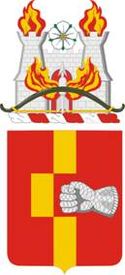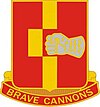
The 3rd Battalion, 16th Field Artillery Regiment is a field artillery battalion assigned to the 2nd Brigade Combat Team, 4th Infantry Division. Carrying the lineage of Battery C, 16th Field Artillery Regiment, the battalion carries campaign streamers from World War I, World War II, and Vietnam, and has served with the 4th Infantry Division and 8th Infantry Division. The unit's nickname is "Rolling Thunder", and their motto is "Macte Nova Virtute". The battalion is composed of a headquarters and headquarters battery (HHB), three cannon batteries, and has an attached Forward Support Company, Company F, 15th Brigade Support Battalion.

The 5th Field Artillery Regiment was constituted as part of the Regular Army in January 1907. Individual battalions have lineages which date back further. Currently, it is a parent regiment under the U.S. Army Regimental System, with a single active battalion, the 1st Battalion, 5th Field Artillery, which is assigned to the 1st Brigade Combat Team, 1st Infantry Division at Fort Riley, Kansas.

The 2nd Battalion, 1st Air Defense Artillery Regiment is a battalion in the 1st Air Defense Artillery Regiment, a regiment in the United States Army, first formed in 1812, and based in South Korea.

The 2nd Air Defense Artillery Regiment is an air defense artillery regiment of the United States Army, first formed in 1821 as a field artillery unit.

The 3rd Air Defense Artillery Regiment is an air defense artillery regiment of the United States Army, first formed in 1821 as the 3rd Regiment of Artillery.

The 6th Field Artillery Regiment is a Field Artillery Branch regiment of the United States Army first activated in 1907 from numbered companies of artillery. It was first organized with two battalions.

The 25th Field Artillery Regiment is a field artillery regiment of the United States Army, first constituted 5 July 1918 in the National Army (USA). Although the regiment did not see action during World War I, elements participated in World War II, Vietnam, Panama, the Gulf War, and the Global War on Terrorism. Currently the regiment one active battalion, a towed light artillery units equipped with the M119A3 105 mm howitzer and the M777A2 155 mm howitzer. The 5th Battalion is assigned to the 3rd Brigade Combat Team, 10th Mountain Division at Fort Johnson, Louisiana. The 4th Battalion was inactivated on 14 August 2014.

The 27th Field Artillery Regiment is a field artillery regiment of the United States Army, first Constituted in 1918 in the National Army (USA).

The 43rd Air Defense Artillery Regiment is an air defense artillery regiment of the United States Army first constituted 1918 in the Regular Army.
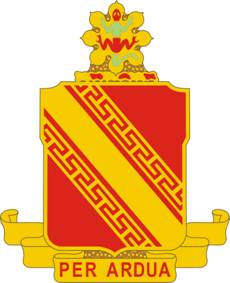
The 44th Air Defense Artillery Regiment is an Air Defense Artillery regiment of the United States Army, first constituted in 1918 in the Regular Army during World War I. During World War II the unit served as the 54th Coast Artillery Regiment
The 1st Battalion, 79th Field Artillery is the only active duty element remaining of the 79th Field Artillery. First constituted on 1 July 1916 in the Regular Army as Troops A (Alpha) and B (Bravo) in the 21st Cavalry, their mission has changed greatly from their Cavalry days. The 1st Battalion, 79th Field Artillery is part of the 434th Field Artillery Brigade charged with the TRADOC mission of Basic Combat Training or BCT of new soldiers to the United States Army.
The 377th Field Artillery Regiment is a field artillery regiment of the United States Army. A parent regiment under the U.S. Army Regimental System, the regiment's 2nd Battalion, 377th Field Artillery Regiment is assigned to the 2nd Infantry Brigade Combat Team (Airborne), 11th Airborne Division. Elements of the regiment have also served with the 101st Airborne Division and 82nd Airborne Division, and have seen service in World War II, Vietnam, and in both Iraq and Afghanistan during the Global War on Terror. The 1st and 3rd Battalions as well as Batteries D and E are Inactive.

The 6th Air Defense Artillery Regiment is an air defense artillery regiment in the United States Army, first formed in 1898 as the 6th Regiment of Artillery. The 6th and 7th U.S. Artillery Regiments were constituted on 8 March 1898, three weeks after the explosion of the USS Maine in Havana, Cuba on 15 February 1898, as the United States' declaration of war on Spain and commencement of the Spanish–American War seemed imminent.

The 2nd Battalion, 27th Field Artillery Regiment is an inactive field artillery battalion of the United States Army, last assigned to the 3rd Armored Division Artillery before its inactivation in 1988. Its parent regiment is the 27th Field Artillery Regiment.

The 2nd Infantry Division Artillery (DIVARTY) or "Warrior Strike" is the Force Field Artillery Headquarters for the 2nd Infantry Division. The DIVARTY served with the division from 1917 to present, including combat service in World War I, World War II, and the Korean War. In addition to peacetime service with the division at Fort Lewis, Washington, Fort Benning, Georgia, and in Japan and Alaska, the DIVARTY spent 40 years in Korea. After seven years stationed at Joint Base Lewis–McChord, where the DIVARTY provided fire support coordination and mission command for the training and readiness of five field artillery battalions, the Army restationed the DIVARTY to Camp Humphreys on 16 September 2021.
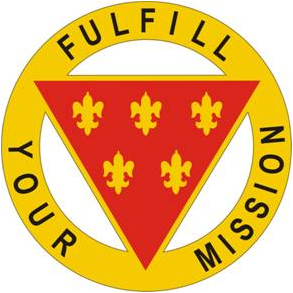
The 3rd Infantry Division Artillery (DIVARTY) is the divisional artillery command for the 3rd Infantry Division at Fort Stewart, Georgia. The DIVARTY has served with the division in World Wars I and II, the Korean War, Operation Iraqi Freedom, and in peacetime at Fort Stewart and Germany. The DIVARTY was inactivated in 2004 as part of transformation to modular brigade combat teams, but was reactivated on 17 October 2014 to provide fire support coordination and mission command for the training and readiness of Field Artillery units across the division.

The 2nd Battalion, 3rd Field Artillery Regiment is an artillery unit of the United States Army. The battalion traces its lineage to 1812, and it is currently assigned to the 1st Brigade Combat Team, 1st Armored Division. The battalion has served in the Seminole Wars, the Civil War, the Spanish–American War, World War I, World War II, Operations Desert Shield and Desert Storm, Operation Iraqi Freedom, and Operation Enduring Freedom.
The 1st Cavalry Division Artillery (DIVARTY) or "Red Team" is the Force Field Artillery Headquarters for the 1st Cavalry Division. The DIVARTY served with the division from 1941 to 2005, including combat service in World War II, the Korean War, the Vietnam War, Operations Desert Shield and Desert Storm, and Operation Iraqi Freedom and in peacetime in Japan, Korea, and Fort Cavazos, Texas. As the Force Fires Headquarters, the DIVARTY provides fire support coordination and mission command for the training and readiness of field artillery units across the division.
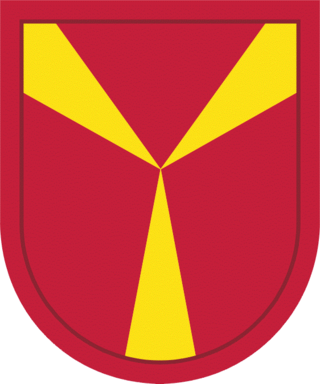
The 1st Battalion, 377th Field Artillery Regiment, is an inactive M198 Howitzer/ M777 Howitzer 155mm field artillery battalion of the United States Army. The battalion has seen service with the 101st Airborne Division during World War II and Vietnam, and deployed to Iraq and Afghanistan during the Global War on Terror. The battalion has been stationed with the 101st Airborne Division at Fort Campbell; with the 18th Field Artillery Brigade and the 82nd Airborne Division at Fort Bragg, North Carolina; and with the 17th Field Artillery Brigade at Fort Lewis, Washington.
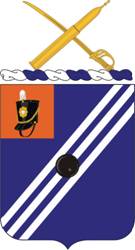
The 1st Battalion, 76th Field Artillery Regiment is an inactive field artillery battalion of the United States Army. The battalion has been assigned to the 3rd Infantry Division, 7th Infantry Division, 2nd Infantry Brigade, and as a separate field artillery battalion. The battalion has participated in World War I, World War II, Operation Iraqi Freedom, and Operation Enduring Freedom. The battalion inactivated in 2015 as part of Army force reductions.
